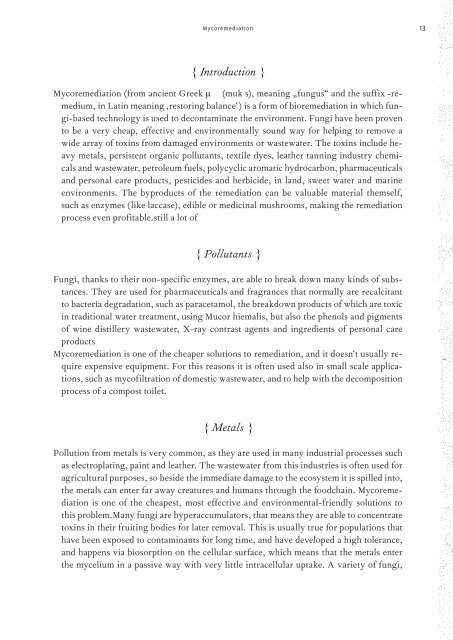Logbuch_17x24Druck_einzelseiten
Create successful ePaper yourself
Turn your PDF publications into a flip-book with our unique Google optimized e-Paper software.
Mycoremediation<br />
13<br />
{ Introduction }<br />
Mycoremediation (from ancient Greek μύκης (mukēs), meaning „fungus“ and the suffix -remedium,<br />
in Latin meaning ‚restoring balance‘) is a form of bioremediation in which fungi-based<br />
technology is used to decontaminate the environment. Fungi have been proven<br />
to be a very cheap, effective and environmentally sound way for helping to remove a<br />
wide array of toxins from damaged environments or wastewater. The toxins include heavy<br />
metals, persistent organic pollutants, textile dyes, leather tanning industry chemicals<br />
and wastewater, petroleum fuels, polycyclic aromatic hydrocarbon, pharmaceuticals<br />
and personal care products, pesticides and herbicide, in land, sweet water and marine<br />
environments. The byproducts of the remediation can be valuable material themself,<br />
such as enzymes (like laccase), edible or medicinal mushrooms, making the remediation<br />
process even profitable.still a lot of<br />
{ Pollutants }<br />
Fungi, thanks to their non-specific enzymes, are able to break down many kinds of substances.<br />
They are used for pharmaceuticals and fragrances that normally are recalcitant<br />
to bacteria degradation, such as paracetamol, the breakdown products of which are toxic<br />
in traditional water treatment, using Mucor hiemalis, but also the phenols and pigments<br />
of wine distillery wastewater, X-ray contrast agents and ingredients of personal care<br />
products<br />
Mycoremediation is one of the cheaper solutions to remediation, and it doesn‘t usually require<br />
expensive equipment. For this reasons it is often used also in small scale applications,<br />
such as mycofiltration of domestic wastewater, and to help with the decomposition<br />
process of a compost toilet.<br />
{ Metals }<br />
Pollution from metals is very common, as they are used in many industrial processes such<br />
as electroplating, paint and leather. The wastewater from this industries is often used for<br />
agricultural purposes, so beside the immediate damage to the ecosystem it is spilled into,<br />
the metals can enter far away creatures and humans through the foodchain. Mycoremediation<br />
is one of the cheapest, most effective and environmental-friendly solutions to<br />
this problem.Many fungi are hyperaccumulators, that means they are able to concentrate<br />
toxins in their fruiting bodies for later removal. This is usually true for populations that<br />
have been exposed to contaminants for long time, and have developed a high tolerance,<br />
and happens via biosorption on the cellular surface, which means that the metals enter<br />
the mycelium in a passive way with very little intracellular uptake. A variety of fungi,


